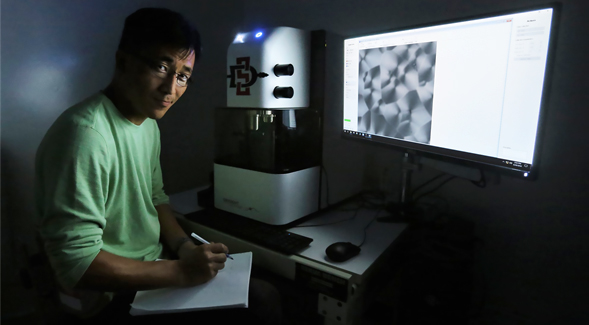Distinctive New Microscope at SDSU Allows for Groundbreaking Research
There are fewer than two dozen SperoQT microscopes in use around the world.

“This instrument will allow us to see this at a real, defined, chemical level that nobody else has been able to see yet. It’s going to be very powerful.”
As a San Diego State University student in 1981, Tim Day could not have imagined that 37 years later he would be at the helm of a company that would make a truly transformative gift to the university’s science enterprise.
Day is the son of SDSU President Emeritus Thomas Day and co-founder of DRS Daylight Solutions, a company that recently donated a $475,000 newly developed chemical imaging microscope called the SperoQT to SDSU’s College of Sciences.
The instrument uses lasers to identify the chemical composition of a specimen, in addition to the visual markers of traditional microscopy.
Materials interact with light differently; for example, DNA and proteins each absorb light at a unique wavelength on the infrared spectrum. The microscope uses tunable infrared lasers to analyze these interactions and identify the chemical components of a sample, and build the components into a highly detailed image.
It’s this way of unpacking the chemical makeup of a sample that sets the Spero apart from other microscopes. There are fewer than two dozen Spero microscopes in labs around the world, and the instrument’s novel approach to analyzing materials allows for groundbreaking experiments.
Ingrid Niesman, director of SDSU’s Electron Microscope Imaging Facility (EMIF), says faculty are already lining up to use this new technology, including a researcher who works on heart fibrosis and a scientist who examines how the flu affects lung tissue.
Visible microscopically
Niesman researches amyloid plaques, a type of protein deposit, in the brains of people suffering from Alzheimer’s disease. Using Spero’s chemical imaging, she is now able to see where plaques form in the brain before the deposits are visible microscopically.
“We don’t know where amyloids start to form. Is it intracellularly? Is it extracellularly? This instrument will allow us to see this at a real, defined, chemical level that nobody else has been able to see yet. It’s going to be very powerful.”
Already, German scientists using the tool have discovered that there are three subcategories of kidney cancer, something not previously known before the researchers began using the Spero.
No other local universities have a similar instrument, and Niesman has invited researchers from other Southern California universities, such as the University of California, San Diego, to use the Spero to support their research.
READ: SDSU Introduces New Research Website
“It truly is an interdisciplinary instrument. It’s a cutting-edge instrument,” Tim Day said. “It has physics involved, it’s got engineering, it’s got optics, biology, material science.”
In that way, Day said, it’s the perfect technology to be housed in the EMIF next to the new Engineering and Interdisciplinary Sciences Complex, which opened in January and is part of a broader university effort to increase collaboration in STEM fields. The Thomas B. Day Quad, a courtyard in the center of the building, was dedicated in honor of Thomas Day, a theoretical physicist, and made possible by donations from the Day family.
Donating one of the company’s trademark technologies to SDSU made perfect sense to the leaders of DRS Daylight Solutions, an infrared technology company that has deep connections to SDSU. Its three founders all received degrees from SDSU and more than a dozen of its San Diego office employees are SDSU alumni.
Stanley Maloy, SDSU associate vice president of research and innovation, said: “This is a wonderful example of how SDSU alumni giving back to the university will have a profound impact on our educational and research opportunities for many years to come, providing unique opportunities for our students and faculty.”
Media Contacts:
La Monica Everett-Haynes
Media Relations Director
619-594-0232
[email protected]
Cory Marshall
Media Relations Officer
619-594-0279
[email protected]



